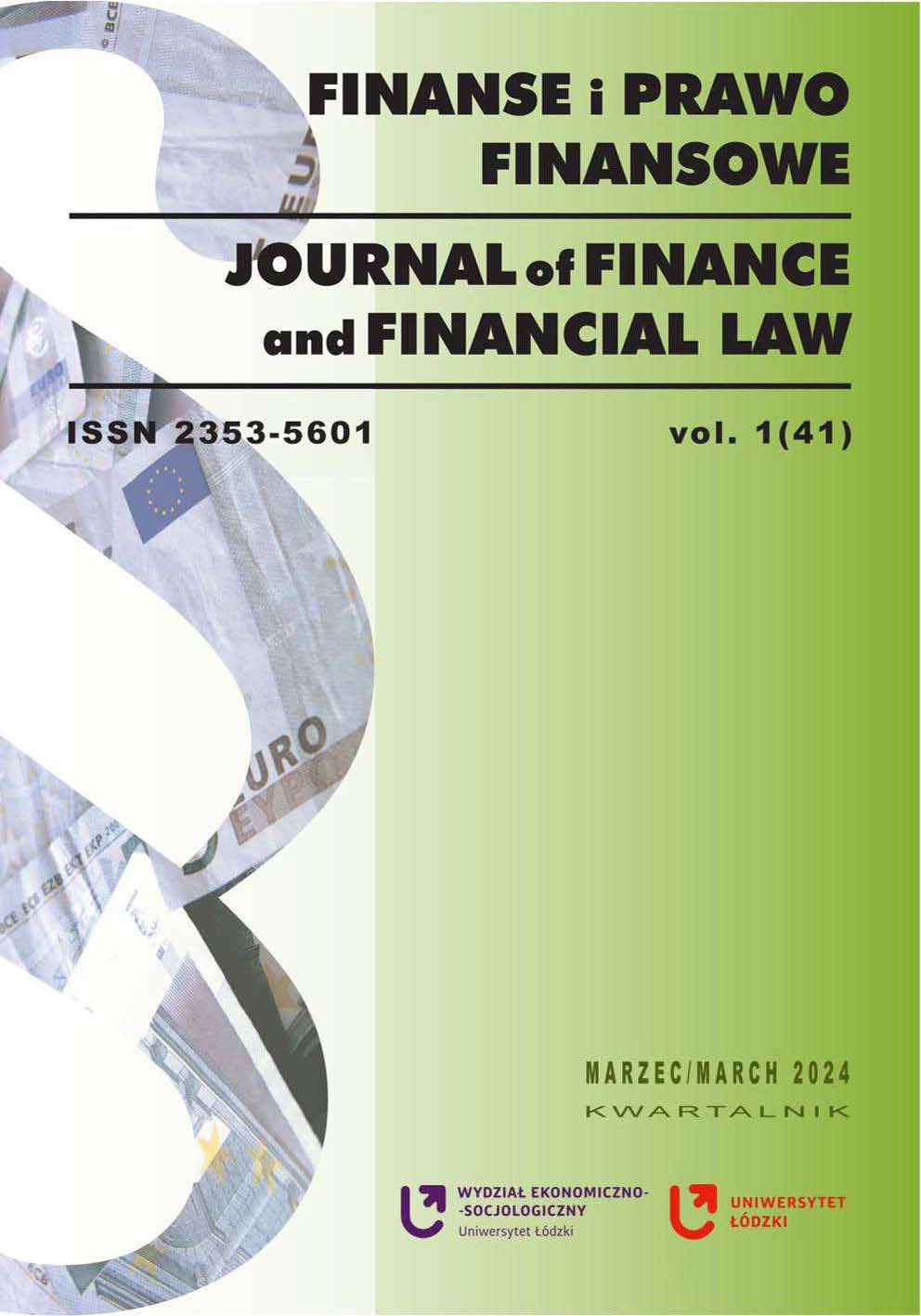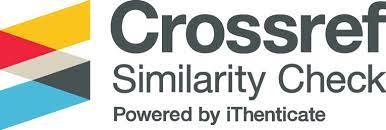Dividend Decisions and Long-Term Returns. The Case of the Polish Stock Market
DOI:
https://doi.org/10.18778/2391-6478.1.41.03Keywords:
dividend, public companies, stock market, long-term returnsAbstract
The purpose of the article. The purpose of the article was to examine how dividend decisions made by general shareholder meetings affect the stock price of public companies in Poland over the long term.
Methodology. The study analyzed the impact of dividend decisions on the long-term patterns of stock returns using the buy-and-hold abnormal returns approach. In addition, the role of the dividend yield ratio in the formation of cross-sectional return volatility was examined. The conducted study referred to public companies listed on the main market of the Warsaw Stock Exchange.
Results of the research. The results of the research can be summarized as follows. Firstly, the conducted empirical study showed the possibility of achieving abnormal returns on investments in portfolios composed of shares of dividend companies. The results showed the positive impact of dividend decisions on valuations of public companies in the long term. Stock portfolios of companies initiating and resuming dividend payments allow for obtaining positive abnormal returns over the long term, however, the returns achieved are statistically significant only for selected periods of stock holding. Secondly, the empirical study of cross-sectional returns showed possibility of achieving in the long term excess returns on shares of public companies with high dividend yields. The results achieved are in line with the results of research conducted for developed stock markets. The articel extends the considerations carried out for the Polish stock market in terms of the impact of dividend decisions on stock returns by including a long period in the analysis.
Downloads
References
Abarbanell, J.S. i Bushee, B.J. (1998). Abnormal Returns to a Fundamental Analysis Strategy. The Accounting Review, 73(1), ss. 19–45.
Google Scholar
Aharony, J. i Swary, I. (1980). Quarterly Dividend and Earnings Announcements and Stockholders' Returns: An Empirical Analysis. The Journal of Finance, 35(1), ss. 1–12.
Google Scholar
DOI: https://doi.org/10.1111/j.1540-6261.1980.tb03466.x
Amihud, Y. i Murgia, M. (1997). Dividends, Taxes, and Signaling: Evidence from Germany. Journal of Finance, 52(1), ss. 397–408.
Google Scholar
DOI: https://doi.org/10.1111/j.1540-6261.1997.tb03822.x
Ang, A. i Bekaert, G. (2007). Stock Return Predictability: Is It There? Review of Financial Studies, 20, ss. 651–707.
Google Scholar
DOI: https://doi.org/10.1093/rfs/hhl021
ap Gwilym, O., McManus, I.D. i Thomas, S. (2005). Dividend Yield Investment Strategies, the Payout Ratio and Zero-Dividend Stocks. The Journal of Investing, 14(4), ss. 69–74.
Google Scholar
DOI: https://doi.org/10.3905/joi.2005.605284
Asquith, P. i Mullins, D.W. (1983). The Impact of Initiating Dividend Payments on Shareholders' Wealth. The Journal of Business, 56(1), ss. 77–96.
Google Scholar
DOI: https://doi.org/10.1086/296187
Baker, M. i Wurgler, J. (2016). Dividends as Reference Points: A Behavioral Signaling Approach. The Review of Financial Studies, 29(3), p. 697–738.
Google Scholar
Benartzi, S., Michaely, R. i Thaler, R.H. (1997). Do Changes in Dividends Signal the Future or the Past? The Journal of Finance, 52(3), ss. 1007–1034.
Google Scholar
DOI: https://doi.org/10.1111/j.1540-6261.1997.tb02723.x
Bhattacharya, S. (1979). Imperfect information, dividend policy, and "the bird in the hand" fallacy. The Bell Journal of Economics, 10(1), ss. 259–270.
Google Scholar
DOI: https://doi.org/10.2307/3003330
Black, F. i Scholes, M.S. (1974). The Effects of Dividend Yield and Dividend Policy on Common Stock Prices and Returns. Journal of Financial Economics, 1(1), ss. 1–22.
Google Scholar
DOI: https://doi.org/10.1016/0304-405X(74)90006-3
Boehme, R.D. i Sorescu, S.M. (2002). The Long-Run Performance Following Dividend Initiations and Resumptions: Underreaction or Product of Chance? The Journal of Finance, 57(2), ss. 871–900.
Google Scholar
DOI: https://doi.org/10.1111/1540-6261.00445
Brzeszczyński, J. i Gajdka, J. (2007). Dividend-Driven Trading Strategies: Evidence from the Warsaw Stock Exchange. International Advances in Economic Research, 13(3), p. 285–300.
Google Scholar
DOI: https://doi.org/10.1007/s11294-007-9077-z
Campbell, J.Y. i Shiller, R.J. (1988a). Stock Prices, Earnings, and Expected Dividends. Journal of Finance, 13(3), ss. 661– 676.
Google Scholar
DOI: https://doi.org/10.1111/j.1540-6261.1988.tb04598.x
Campbell, J.Y. i Shiller, R.J. (1988b). The Dividend-Price Ratio and Expectations of Future Dividends and Discount Factors. Review of Financial Studies, 1(3), ss. 195– 227.
Google Scholar
DOI: https://doi.org/10.1093/rfs/1.3.195
Carhart, M.M. (1997). On Persistence in Mutual Fund Performance. The Journal of Finance, 52(1), ss. 57–82.
Google Scholar
DOI: https://doi.org/10.1111/j.1540-6261.1997.tb03808.x
Chen, S.-S., Chou, R. i Lee, Y.-C. (2014). The long-term performance following dividend initiations and resumptions revisited. Journal of Economics and Finance, 38(4), ss. 643–657.
Google Scholar
DOI: https://doi.org/10.1007/s12197-012-9243-x
Chui, A.C., Titman, S. i Wei, K.J. (2010). Individualism and Momentum Around the World. The Journal of Finance, 65(1), ss. 361–392.
Google Scholar
DOI: https://doi.org/10.1111/j.1540-6261.2009.01532.x
Cochran, S., DeFina, R. i Mills, L. (1993). International Evidence on the Predictability of Stock Returns. Financial Review, 28(2), ss. 159–180.
Google Scholar
DOI: https://doi.org/10.1111/j.1540-6288.1993.tb01343.x
Czapiewski, L. i Kubiak , J. (2017). Reakcja inwestorów na zapowiedzi wysokości dywidend spółek notowanych na GPW w Warszawie. Finanse, Rynki Finansowe, Ubezpieczenia, 2(86), ss. 47–58.
Google Scholar
DOI: https://doi.org/10.18276/frfu.2017.86-04
Czekaj, J. (2014). Efektywność giełdowego rynku akcji w Polsce z perspektywy dwudziestolecia. Warszawa: PWE.
Google Scholar
De Moor, L. i Sercu, P. (2013). The smallest firm effect: An international study. Journal of International Money and Finance, 32, ss. 129–155.
Google Scholar
DOI: https://doi.org/10.1016/j.jimonfin.2012.04.002
Fama, E.F. i French , K. (1988). Dividend Yields and Expected Stock Returns. Journal of Financial Economics, 22, ss. 3–26.
Google Scholar
DOI: https://doi.org/10.1016/0304-405X(88)90020-7
Fama, E.F. i MacBeth, J.D. (1973). Risk, Return, and Equilibrium: Empirical Tests. The Journal of Political Economy, 81(3), ss. 607–636.
Google Scholar
DOI: https://doi.org/10.1086/260061
Frasyniuk-Pietrzyk, M. i Walczak, M. (2014). Wpływ informacji o wypłacie dywidendy na notowania spółek na GPW w Warszawie w latach 2006–2013. Zeszyty Naukowe Wyższej Szkoły Bankowej we Wrocławiu, 7(45), ss. 119–128.
Google Scholar
Gnap, M. (2022). Market reactions to dividends announcements: evidence from the Warsaw Stock Exchange. Ruch Prawniczy, Ekonomiczny i Socjologiczny, 84(2), ss. 193–207.
Google Scholar
DOI: https://doi.org/10.14746/rpeis.2022.84.2.13
Goetzmann, W.N. i Jorion, P. (1993). Testing the Predictive Power of Dividend Yields. Journal of Finance, 48(2), ss. 663– 679.
Google Scholar
DOI: https://doi.org/10.1111/j.1540-6261.1993.tb04732.x
Goyal, A. i Welch, I. (2003). The Myth of Predictability: Does the Dividend Yield Forecast the Equity Premium? Management Science, 49(5), ss. 639–654.
Google Scholar
DOI: https://doi.org/10.1287/mnsc.49.5.639.15149
Gurgul, H. (2006). Analiza zdarzeń na rynkach akcji. Wydanie pierwsze ed. Kraków: Oficyna Ekonomiczna.
Google Scholar
Gurgul, H. i Majdosz, P. (2005). Effect of Dividend and Repurchase Announcements on the Polish Stock Market. Badania Operacyjne i Decyzje, 1, ss. 25–41.
Google Scholar
Healy, P.M. i Palepu, K.G. (1988). Earnings information conveyed by dividend initiations and omissions. Journal of Financial Economics, 21(2), ss. 149–175.
Google Scholar
DOI: https://doi.org/10.1016/0304-405X(88)90059-1
Kaźmierska-Jóźwiak, B. (2017). Reakcja rynku kapitałowego na inicjowanie dywidend na rynku polskim. Ekonomika i Organizacja Przedsiębiorstwa, 22, ss. 109–118.
Google Scholar
Khan, M. (2011). Conceptual Foundations of Capital Market Anomalies. In: L. Zacks, ed., The Handbook of Equity Market Anomalies. Hoboken, New Jersey: John Wiley & Sons, Inc., ss. 1–22.
Google Scholar
DOI: https://doi.org/10.1002/9781119200697.ch1
Kyriazis, D. i Diacogiannis, G. (2007). Testing the performance of value strategies in the Athens Stock Exchange. Applied Financial Economics, 17(18), ss. 1511–1528.
Google Scholar
DOI: https://doi.org/10.1080/09603100600949226
Lev, B. i Thiagarajan, R. (1993). Fundamental Information Analysis. Journal of Accounting Research, 31(2), ss. 190–215.
Google Scholar
DOI: https://doi.org/10.2307/2491270
Lewellen, J. (2004). Predicting Returns with Financial Ratios. Journal of Financial Economics, 74, ss. 209–235.
Google Scholar
DOI: https://doi.org/10.1016/j.jfineco.2002.11.002
Lewellen, J. (2011). Institutional investors and the limits of arbitrage. Journal of Financial Economics, 102, ss. 62–80.
Google Scholar
DOI: https://doi.org/10.1016/j.jfineco.2011.05.012
Lewellen, J. (2015). The cross section of expected stock returns. Critical Finance Review, 4, ss. 1–44.
Google Scholar
DOI: https://doi.org/10.1561/104.00000024
Lintner, J. (1965). The Valuation of Risk Assets and the Selection of Risky Investments in Stock Portfolios and Capital Budgets. The Review of Economics and Statistics, 47(1), ss. 13–37.
Google Scholar
DOI: https://doi.org/10.2307/1924119
Litzenberger, R.H. i Ramaswamy, K. (1979). The effects of dividends on common stock pricestax effects or information effects? Journal of Finance, 37(2), ss. 429–443.
Google Scholar
DOI: https://doi.org/10.1111/j.1540-6261.1982.tb03565.x
Lyn, E. i Zyowicsch, E. (2004). Predicting stock returns in the developing markets of Eastern Europe. Journal of Investing, 13(2), ss. 63–71.
Google Scholar
DOI: https://doi.org/10.3905/joi.2004.412309
McInish, T.H., Ding, D.K., Pyun, C.S. i Wongchoti, U. (2008). Short-horizon contrarian and momentum strategies in Asian markets: An integrated analysis. International Review of Financial Analysis, 17(2), ss. 312–329.
Google Scholar
DOI: https://doi.org/10.1016/j.irfa.2006.03.001
Mei, J. (1992). Explaining the Cross-Section of Returns Via a Multi-factor APT Model. Journal of Financial and Quantitative Analysis, 28(3), ss. 331–345.
Google Scholar
DOI: https://doi.org/10.2307/2331417
Michaely, R., Thaler, R.H. i Womack, K. (1995). Price Reactions to Dividend Initiations and Omissions: Overreaction or Drift? The Journal of Finance, 50(2), ss. 573–608.
Google Scholar
DOI: https://doi.org/10.1111/j.1540-6261.1995.tb04796.x
Morgan, G. i Thomas, S. (1998). Taxes, dividend yields and returns in the UK equity market. Journal of Banking & Finance, 22(4), ss. 405–423.
Google Scholar
DOI: https://doi.org/10.1016/S0378-4266(98)00002-8
Perepeczo, A. (2013). Reakcja akcjonariuszy na decyzje o wypłacie dywidendy w spółkach publicznych – wyniki badań empirycznych. Prace Naukowe Uniwersytetu Ekonomicznego we Wrocławiu, 323, ss. 253–264.
Google Scholar
Raja, N. i Tajir, A. (2014). Impact of Dividend Policy on Shareholder Wealth. IOSR Journal of Business and Management, 16(1), ss. 24–33.
Google Scholar
DOI: https://doi.org/10.9790/487X-16152433
Rouwenhorst, G.K. (1999). Local Return Factors and Turnover in Emerging Stock Markets. The Journal of Finance, 54(4), ss. 1439–1464.
Google Scholar
DOI: https://doi.org/10.1111/0022-1082.00151
Ross, S.A. (1977). The Determination of Financial Structure: The Incentive-Signalling Approach. The Bell Journal of Economics, 8(1), ss. 23–40.
Google Scholar
DOI: https://doi.org/10.2307/3003485
Skinner, D.J. i Soltes, E.F. (2009). What Do Dividends Tell Us about Earnings Quality? Review of Accounting Studies, 16(1), ss. 1–28.
Google Scholar
DOI: https://doi.org/10.1007/s11142-009-9113-8
Słoński, T. i Zawadzki, B. (2012a). Analiza reakcji inwestorów na zmianę wielkości wypłacanej dywidendy przez spółki notowane na GPW w Warszawie. Annales Universitatis Mariae Curie-Skłodowska. Sectio H. Oeconomia, 1(46), ss. 125–135.
Google Scholar
Słoński, T. i Zawadzki, B. (2012b). The impact of a surprise dividend increase on a stock’s performance – the analysis of companies listed on the Warsaw Stock Exchange. Operations Research and Decisions, 22(2), ss. 46–54.
Google Scholar
Talmor, E. (1981). Assymetric information, signaling and optimal corporate financial decisions. Journal of Financial and Quantitative Analysis, 16(4), ss. 413–435.
Google Scholar
DOI: https://doi.org/10.2307/2330363
Tuzimek, R. (2012). Wpływ wypłat dywidendy na wartość akcji spółek notowanych na Giełdzie Papierów Wartościowych w Warszawie. Prace Naukowe Uniwersytetu Ekonomicznego we Wrocławiu, 254, ss. 333–346.
Google Scholar
Visscher, S. i Filbeck, G. (2003). Dividend-Yield Strategies in the Canadian Stock Market. Financial Analysts Journal, 59(1), ss. 99–106.
Google Scholar
DOI: https://doi.org/10.2469/faj.v59.n1.2506
Zaremba, A., Czapkiewicz, A., Szczygielski, J.J. i Kaganov, V. (2019). An Application of Factor Pricing Models to the Polish Stock Market. Emerging Markets Finance and Trade, 9(55), ss. 2039–2056.
Google Scholar
DOI: https://doi.org/10.1080/1540496X.2018.1517042
Zaremba, A. i Konieczka, P. (2015). Znaczenie stopy dywidendy w optymalizacji portfela akcji na rynku Europy Środkowo-Wschodniej. Ekonomista, 6, ss. 857–877.
Google Scholar
Żyła, M. (2018). Teoria sygnalizacji w polityce dywidend na przykładzie spółek notowanych na NewConnect. Ekonomia XXI Wieku, 4(20), ss. 100–117.
Google Scholar
DOI: https://doi.org/10.15611/e21.2018.4.08
Downloads
Published
How to Cite
Issue
Section
License

This work is licensed under a Creative Commons Attribution-NonCommercial-NoDerivatives 4.0 International License.














